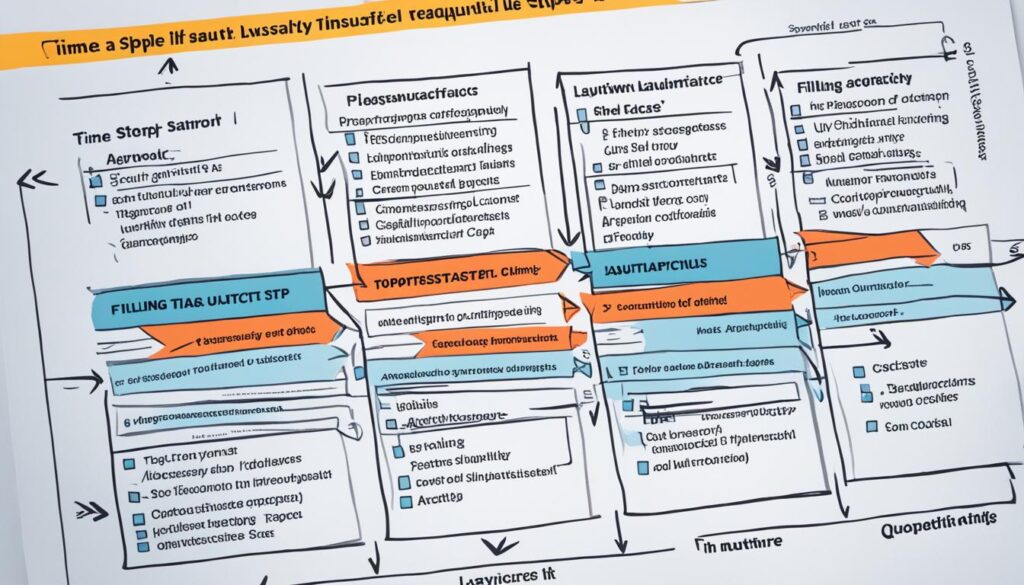If an attorney does something wrong and it hurts their client, that person can sue. But, there’s a time limit to do so. This limit changes from state to state. It’s important to know this and other rules to make sure you can file a claim on time.
Key Takeaways
- The statue of limitations for attorney malpractice claims can range from as little as 1 year to as much as 3 years, depending on the state.
- The “discovery rule” may extend the filing deadline if the client was unaware of the malpractice until a later date.
- Certain factors, such as mental incapacity or military service, can “toll” or pause the statute of limitations.
- In addition to the statute of limitations, there may be other procedural requirements, such as filing a notice of claim or obtaining an affidavit of merit.
- The potential damages recoverable in an attorney malpractice lawsuit can include medical expenses, lost income, pain and suffering, and more.
Understanding Attorney Malpractice
Attorney malpractice is when a lawyer doesn’t give good representation, causing harm to a client. This happens if the lawyer doesn’t meet their duty of care. It might be from missing deadlines, giving wrong advice, not getting important evidence, or being in a conflict of interest with the client.
Malpractice can also happen if the lawyer doesn’t put the client’s best interests first.
What Constitutes Attorney Malpractice?
Attorney malpractice means a lawyer didn’t take as much care, skill, and effort as they should have. It’s when their actions or lack of action doesn’t meet the standard care expected from a professional.
Common Examples of Attorney Negligence
Examples of attorney negligence leading to malpractice claims include:
- Missing court filing deadlines or statutes of limitations, resulting in the client’s case being dismissed
- Providing inaccurate or inappropriate legal advice that causes the client harm
- Failing to properly investigate a client’s case or secure necessary evidence
- Engaging in conflicts of interest by representing parties with opposing interests
- Improperly handling or misappropriating a client’s funds or assets
- Failing to follow a client’s explicit instructions regarding the handling of their legal matter
It’s hard to prove attorney malpractice. The client must show the lawyer’s actions were below standard and directly led to harm. The client has to prove the lawyer didn’t follow through on their duty, causing real harm.
“Winning a malpractice case against an attorney is very challenging. To prove malpractice, four elements need to be demonstrated: duty, breach, causation, and damages.”
Statute of Limitations for Attorney Malpractice Claims

To handle attorney malpractice claims, you must know about statute of limitations. Each state has its own time limit for filing lawsuits against lawyers for their mistakes. These limits, usually between one to six years, start when the client finds out about the mistake.
Most states won’t let you file a claim past a certain number of years, even if you just discovered the mistake. This means if too much time has passed since the mistake happened, you can’t sue. It’s really important to keep these deadlines in mind. Otherwise, your case might get thrown out by the court.
Take Washington for example. If you were a client, once you find out about the mistake, you have three years to sue. In Oregon, you only have two years after finding the mistake to file a claim.
What’s really interesting is that Washington has no set limit for how long a lawsuit can be delayed. This means you might be able to sue even if years have gone by. On the other hand, Oregon used to have a 10-year limit, but this might be changing.
Moreover, tolling agreements can pause the time for filing claims. This gives both parties more time to discuss settling without the rush of a looming deadline.
Knowing the specifics on when to file attorney malpractice claims is very important. If you miss the deadline, your case might be dismissed. It’s key to follow these time limits closely. I advise working with legal experts to make sure you get it right and protect your rights.
how long do you have to sue an attorney for malpractice
When looking at attorney malpractice, the time limit to file a lawsuit is key. This time limit is linked to the “discovery rule.” It starts when you find out or should have found out about the attorney’s mistake.
Discovery Rule and Tolling Provisions
Some states have laws that can stop or extend the time you have, called tolling provisions. Then, there are certain situations that may affect this time:
- If the attorney keeps working on the same issue, after the mistake is made
- If the attorney hides the mistake from you on purpose
- If you couldn’t make legal decisions at that time, like if you were a minor or not able to understand things well
These points matter a lot. They can change when you can file a legal malpractice claim. So, knowing the laws in your state is very important.
| State | Statute of Limitations for Attorney Malpractice |
|---|---|
| New Jersey | Generally 6 years from the date of the malpractice incident |
| Texas | 2 years from the date you found out or should have found out about the mistake |
It is key to remember that these time limits change from state to state. So, talking to a how long to sue attorney for malpractice experienced lawyer in your area is vital. They’ll help you know the exact rules for filing your claim.
“Attorneys being sued for malpractice often cite a delay in the filing of a lawsuit as part of their defence, emphasizing the critical importance of prompt action.”
Knowing about the statute of limitations and the discovery rule can help protect your rights. It ensures you do what’s needed to get fair compensation for attorney malpractice.
Identifying the Commencement of the Statute of Limitations

Figuring out when the statute of limitations starts for lawyer malpractice can be tricky. Usually, the time limit starts when a client finds out about the lawyer’s mistake. Or, it starts when the client should have found out. This is the “discovery rule.”
Continuous Representation Rule
The continuous representation rule lets the statute of limitations wait in certain cases. It means that the time limit doesn’t start until the lawyer finishes working on the issue.
For instance, if a lawyer messes up a case but keeps working on it, the time limit might not count yet. The client gets extra time to find out about the mistake. And they can take action without worrying about the time running out.
But, the rule isn’t always strict. Courts say the rule works only if the lawyer keeps working steadily on that particular case. If the work becomes less or the issue is fully settled, the time could start anyway.
Clients should not wait too long to do something about a lawyer’s mistake. Waiting might reduce their chances of getting help because of the time limit and legal responsibility.
“The statute of limitations can start running from the moment a new attorney discovers malpractice or breach of fiduciary duty by a prior counsel, potentially affecting the outcome of the client’s case.”
Statute of Repose for Attorney Malpractice Claims
States don’t just have a time limit for when you can sue a lawyer, they also set a “statute of repose.” This statute is different because it sets a final deadline for starting a lawsuit. This deadline happens no matter when the problem with the attorney was realized.
The “statute of repose” creates a last day for filing legal malpractice claims. This day exists even if someone did not know about the lawyer’s mistake for a long time. It mostly helps protect attorneys from being sued forever for old mistakes.
The statute of repose is not like the statute of limitations. It doesn’t wait until you find out about the lawyer’s error. It starts counting from when the mistake happened, no matter when the client learns about it.
The time given in the statute of repose varies from state to state. But, usually, it is longer than the statute of limitations. This gives a fair time frame for holding attorneys responsible for their actions.
Keeping an eye on both the statute of limitations and the statute of repose is crucial for clients. Missing the deadline for filing a lawsuit can lead to the case being thrown out. This is true even if the client didn’t know about the attorney’s mistake in time.
| State | Statute of Limitations | Statute of Repose |
|---|---|---|
| Maryland | 3 years from discovery of malpractice | 5 years from date of malpractice |
| Pennsylvania | 2 years from discovery of malpractice | 4 years from date of malpractice |
| New York | 3 years from discovery of malpractice | 6 years from date of malpractice |
The statute of repose is a critical legal principle for protecting the legal profession. It sets a firm limit on how long attorneys can be sued for their mistakes. Understanding both the statute of limitations and the statute of repose helps clients take timely legal action to protect their rights.
Procedural Requirements for Filing a Lawsuit

States have certain rules for when you can sue for attorney malpractice. Besides time limits, they include sending notice to the lawyer and submitting an affidavit of merit. These rules make the lawsuit process different.
Notice Requirements and Affidavit of Merit
Plaintiffs often must tell the lawyer in question they might sue in writing, through certified mail. This can happen from 30 to 180 days before suing. The goal is for the lawyer to solve the issue before a lawsuit.
Some places also need an affidavit of merit. This is a document from an expert. It says the case is possibly good and meets the standard of care. The goal is to help wean out cases that aren’t well-supported or just for fun.
If you don’t do these things right, your lawsuit might be thrown out. It’s super important to know your state’s rules when suing for attorney malpractice to make sure your case is safe.
| Procedural Requirement | Purpose | Potential Consequence of Non-Compliance |
|---|---|---|
| Notice Requirement | To give the lawyer a chance to fix things without going to court | Your lawsuit might be thrown out |
| Affidavit of Merit | To check that cases against lawyers are serious and have a chance | Your lawsuit might be thrown out |
Dealing with the steps to sue for attorney malpractice can be hard. It’s crucial for anyone thinking about this to get help from a legal expert. This ensures you follow all rules and keep your rights safe.
Damages Recoverable in Attorney Malpractice Cases
Plaintiffs can get different types of damages if they win an attorney malpractice case. These often cover the gap between what the client could have gotten and what they actually got. Losses such as missed chances in real estate or business due to attorney errors are included.
Emotional distress damages like pain and suffering usually can’t be claimed in these cases. But, there are special cases. For example, Washington and Oregon sometimes allow it when the harm is severe or the attorney’s actions were very wrong. In Oregon, this might be for losing a crucial relationship.
Rules for claiming emotional distress in malpractice cases vary. Washington has more clear rules than Oregon. In the end, each case is decided on its own. It might not just be linked to money loss but other significant harm too.
| Type of Damages | Description |
|---|---|
| Economic Damages | The gap between the loss and potential gain if the lawyer had done better, including missed chances or profit. |
| Emotional Distress Damages | Rarely paid, but there are some exceptions. In places like Washington and Oregon, you might win if the pain was big or the attorney was very wrong. |
It’s common to feel regret after a legal case, but it might not mean malpractice happened. Clients have the final word on settlements, so they must be sure. However, there are times when an already settled case can be brought back, like with bad advice or errors in the settlement documents.
To wrap up, in attorney malpractice cases, you can aim for economic losses but not often for emotional distress. Yet, in some rare cases and places, emotional distress claims might be possible. It’s key for both sides to understand this for any legal action.
Comparative Negligence and Contributory Client Conduct

In attorney malpractice cases, a client’s actions might matter. This is under comparative negligence and contributory client conduct. These can affect how much a client can get back if their lawyer was negligent.
Comparative negligence means the client’s payout decreases if they contributed to the issue. If the client’s own actions affected the harm, less money is awarded.
Contributory client conduct says a client must try to lower the damage. If the client can make the situation better and doesn’t, they might not get full compensation. Clients are required to do what’s sensible to cut back harm from their lawyer’s mistake.
These two rules, comparative negligence and contributory client conduct, make client and attorney both partly responsible. They also affect how much a client can win in a lawsuit against their attorney.
| Principle | Description | Impact on Client’s Recovery |
|---|---|---|
| Comparative Negligence | The client’s own negligence or fault contributes to the damages suffered. | Client’s damages award is reduced in proportion to their contributory fault. |
| Contributory Client Conduct | The client fails to take reasonable steps to mitigate the damages caused by the attorney’s negligence. | Client’s recovery may be limited or barred if they fail to mitigate damages. |
The rules of comparative negligence and contributory client conduct are key in attorney malpractice. They show how important clients’ actions are in lessening the harm from the lawyer’s mistake.
Arbitration and Alternative Dispute Resolution
Many attorney-client agreements now include rules for settling misunderstandings. They might need arbitration or another way to solve arguments, not taking them to court. These ways can help get a solution quicker, for less money, and more privately.
Arbitration happens outside the court. A neutral person looks at the facts and makes a final decision. It’s usually quicker and cheaper than going to court. Mediation is different. A mediator helps both sides talk and find a way to agree.
Using these different methods has its good points. But, clients should be wary of the rules about arbitration or mediation in their agreements. These rules might make it hard for them to get compensation in court later. A good lawyer can make sure these rules are fair and protect the client.
Deciding on arbitration, mediation, or suing in court depends on each case. Understanding what each way involves is essential. It helps clients figure out the best way to solve their problem and get what they want.
“Arbitration and other forms of alternative dispute resolution can be valuable tools for resolving attorney malpractice claims, but clients must carefully review the terms to ensure their rights are protected.”
Ethical Considerations and Professional Disciplinary Actions

If a lawyer behaves badly or makes a mistake, they might not just get sued for malpractice. They could also face serious consequences from their state’s bar association or other groups. These problems might lead to their license being taken away.
Lawyers are expected to act in the best interests of their clients. If they don’t, they could end up in trouble with the bar association. This could happen for lots of reasons, like not doing their job, missing deadlines, misusing money, or keeping important information from their clients.
To win a malpractice case, the person suing has to prove a few things. They need to show there was a lawyer-client relationship, the lawyer made a mistake, the mistake hurt the client, and it caused damage. The main goal here is to help the client get compensated.
But there’s also another goal in these cases. The system also wants to keep lawyers honest and protect people. So, if a lawyer does something very wrong, they might get their license suspended or taken away.
Some places make lawyers tell on themselves if they break the rules. This can bring more consequences. Professional disciplinary actions can mean going to classes, getting yelled at, or even losing your license.
“Every lawyer owes their client a fiduciary duty. Breaching this duty can result in the lawyer being held liable.”
Lawyers always have to follow the rules. Breaking them can be really bad, affecting not only their lives but also how people trust the legal system. It’s always smart to have a good lawyer if you’re dealing with a malpractice case.
Being ethical in the law world is really important. Studies have shown that many lawyers face malpractice claims every year. This is a big issue that affects both experienced and new lawyers.
Conclusion
It’s really important to know the time limits and steps needed for an attorney malpractice lawsuit. The key takeaways include understanding that these rules can differ from state to state. It’s vital to handle them with care. Remember, rules such as comparative negligence may affect how much you can recover.
When finding an attorney for a malpractice claim, reach out to a legal malpractice expert. They can guide you through the legal process and ensure your claim is timely. Taking prompt next steps includes getting advice on your case and deciding how to move forward.
Success in an attorney malpractice claim depends on knowing the laws and gathering the right evidence. Make sure you protect your rights. This way, you can make attorneys take responsibility for their mistakes and get the compensation you’re entitled to.
